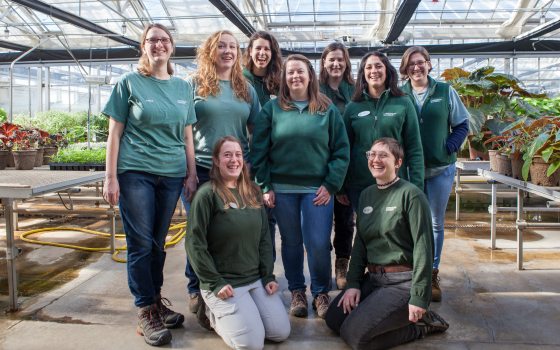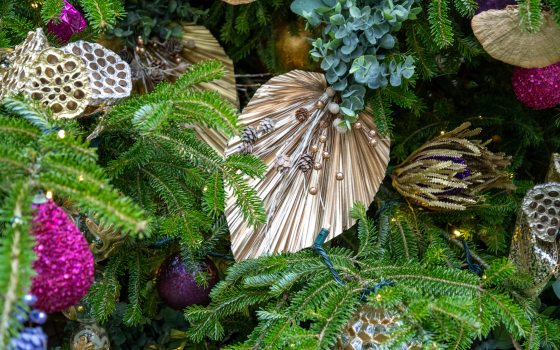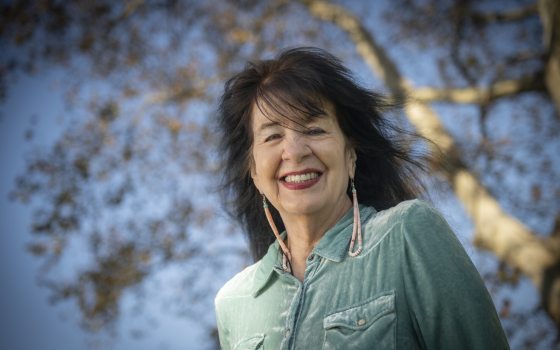While children splash in a summertime pool, one little girl crouches on the concrete, gazing at a line of ants marching across the pavement. Ashley Clayton smiles at the memory. “That’s when my mom knew I would be a scientist.”
Our 2018 Community Read, now in its fifth year, features three titles and a multitude of activities that celebrate female scientists: Lab Girl by Hope Jahren, Women in Science by Rachel Ignotofsky, and The Tree Lady by H. Joseph Hopkins. At Longwood, our dedicated staff, students, and volunteers—many of them women—work behind the scenes to bring you the beauty of our Gardens through the art and science of horticulture. We’d like you to meet two of them.
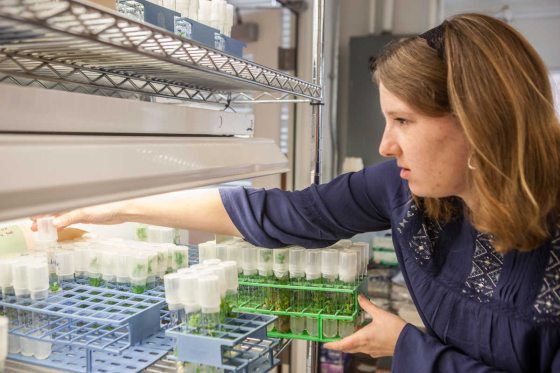
One year into her job as Research Specialist, Ashley Clayton tends the tissue culture lab, soil lab, and four experimental greenhouses at Longwood. “This is my library of plants,” she says, opening a fridge packed with test tubes, each cradling one of the 230 chrysanthemum types grown here. These tiny mums—living in a medium of nutrients, plant hormones, sugar, and agar—start out as cuttings from virus-free plants, or are isolated from the meristem (a part of the shoot that grows so fast that viruses don’t usually attack it). This tissue culture stock helps to supply the high numbers of hard-to-get plants needed for Longwood’s displays—like the 425 cuttings that an intern is now growing for this fall’s Chrysanthemum Festival.
"No single day is the same,” says Ashley, who also works with Curator and Plant Breeder Peter Zale on the conservation of native terrestrial orchids, a project she began as an intern. What day length does Spiranthes casei need in tissue culture? What soil does it like? Asking questions like these might help to increase populations of these rare plants, and, of course, leads to more questions. The research team is now studying the natural relationship between native orchids and fungi—if you introduce the right fungus, will it help the orchids to grow?
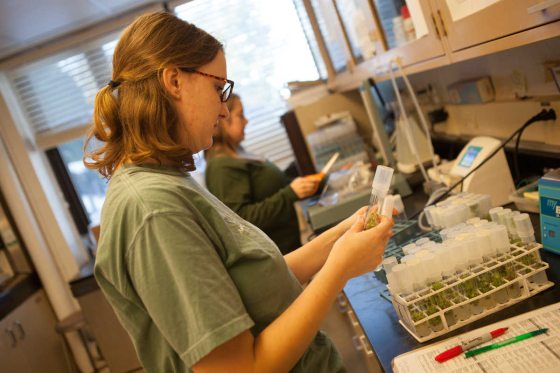
Ashley earned a B.A. in biological sciences at Clemson, where a course in plant taxonomy sparked her interest in horticulture. But she credits her Longwood internship with providing hands-on experience and a foot in the door, and she encourages students to take advantage of similar opportunities. “It helped me to learn a lot about Longwood’s research programs, including its breeding program, which gives us a chance to create something new and exciting.”
One entire greenhouse is dedicated to breeding Camellia, in order to improve its cold hardiness and perhaps to produce an ever-blooming plant. Another greenhouse holds Clivia—“a plant that grows naturally in South Africa, beneath the trees. Imagine how beautiful that must look,” says Ashley. “It’s typically orange, but when Sir John Thouron found a yellow one, it kicked off our breeding program, which started in 1976.”
Ashley’s remaining greenhouses are more eclectic, with some plants collected from exploration trips, which she hopes to take part in someday, and others used for trial evaluations. “With our Winter Blues Festival coming up in March, we can study a plant to see if it’s truly blue. Does it flower differently under glass? Is the timing different?”

“I loved science growing up,” says Ashley. “My parents say I was always asking questions and observing things. I also love crafts, which helps with fine motor skills. I work with pipettes measured in microliters and orchid seeds that are dust, which you need a microscope to see.” But being a woman in science never really crosses Ashley’s mind, having always had teachers and family who fully support her passion for science. “I think it is important to throw out social constraints, expose women to the various careers in science, and encourage them to pursue their interests.”
While Ashley is researching plants in the lab, Rachel Schnaitman is scouting out mites in the greenhouses. As Manager of Longwood’s Integrated Pest Management (IPM) Program—a sustainable approach to managing pests that balances aesthetics, safety, and science—Rachel leads an all-female staff who diagnose and control insects, plant diseases, and viruses, both indoors and out.
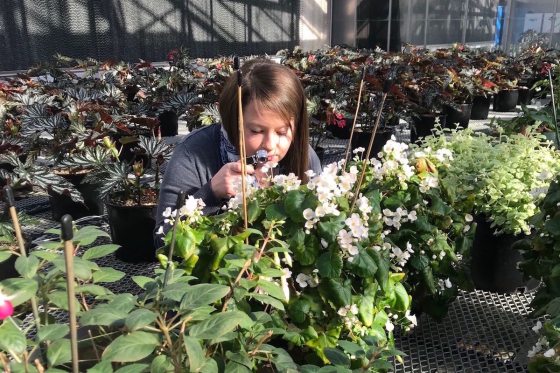
“We’re a team of plant doctors,” says Rachel. “We need to know entomology, plant pathology, biology, virology … on any given day we can be identifying pests under the microscope, culturing plant diseases in petri dishes, or scouting for pests in the landscape,” she explains.
Does she have a favorite insect? “Mealybug destroyers,” she says. This ladybug-sized beetle is beneficial because it eats plant-sucking scale insects, and Rachel is raising a supply of them. Though research isn’t her team’s main focus, they do perform small practical experiments, like coming up with a biological product to control algae in Longwood’s lakes.
Rachel grew up by the Chesapeake Bay and remembers going crabbing and fishing with her family. Her interest in declining populations of bay organisms led her to pursue a B.S. in wildlife conservation at the University of Delaware, and an M.S. in biodiversity and conservation at the University of Oxford in England. Throughout college, she worked in a biological control lab, raising beneficial insects that eat weeds. When a professor showed her a job ad for Longwood, she started part-time in IPM. Six years later, she’s managing the department.

“I think women can be very detail-oriented, which is especially important in science,” says Rachel. “But being a woman in my particular job is very uncharacteristic because of the large pieces of equipment involved.” She has her commercial driver’s license and operates a bucket truck, and can sometimes be found 70 feet in the air doing large tree sprays.
“It can be a challenge to manage all the different areas at Longwood. We deal with six to seven main pests in the Conservatory, and those are easy to identify. But out in the landscape there’s more variation. Some spores are sticky and can cling to clothing, and guests can unknowingly carry them in. So we have to be on the lookout for things like boxwood blight in the Main Fountain Garden.”
Rachel enjoys sharing her knowledge by training staff, students, and interns; talking to tour groups; speaking at conferences; and teaching Pest Identification courses through Longwood’s Continuing Education Department. “We go out and collect pests that people can look at under the microscope—we instruct everyone from hobby gardeners with no background, to industry professionals seeking pesticide renewal credits.”
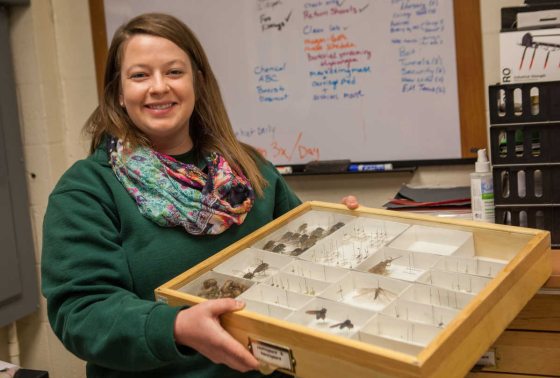
“I’m proud of how this team has grown,” says Rachel, “and that we’re part of making Longwood’s display great. My team is not in the spotlight; yet they are the unsung heroes.” Rachel’s message for those she mentors is one of perseverance. “It took me a while to get where I am,” she says. “Sticking with something and doing a good job is always a good foundation for the future, no matter the field.
“I think it’s on us as Longwood supervisors to reach out to students and talk about these types of careers, or to let them come and spend a day—when I was in school, I didn’t even know this was an option—but now I have a job where I wear different hats and it’s interesting and exciting. What’s nice about Longwood is you get to do things like work on the Christmas display. But being out and about identifying problems: I love that part of my job.”
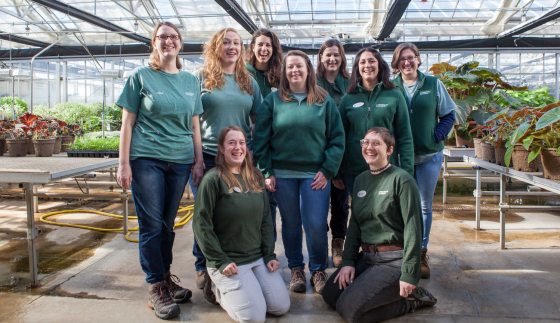
Both Ashley and Rachel agree that science is awesome. Often that awe begins in childhood—on a summer sidewalk, wondering at ants. On a family fishing trip. Or, as was the case with Community Read author Hope Jahren, in her father’s lab and her mother’s garden.
We are Celebrating Women in Science and Horticulture on March 24, 2018—when Hope Jahren, author of national bestseller Lab Girl, joins a panel of local women scientists to talk about their inspiring professional journeys. Hope will be back that evening for a community conversation. Check out the partner events hosted by community groups throughout the region. And pick up our 2018 Community Read books, which also include Women in Science by Rachel Ignotofsky and The Tree Lady by H. Joseph Hopkins. Then start reading to learn how you, too, can become a scientist—or simply be inspired!
